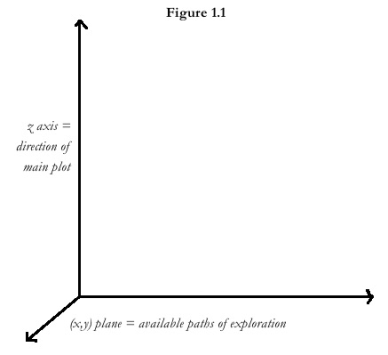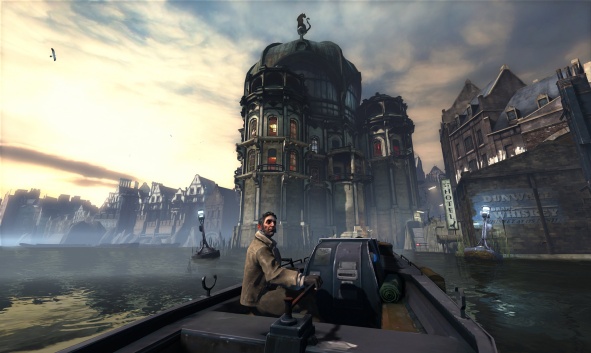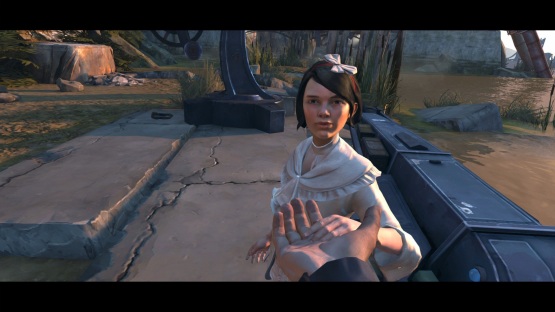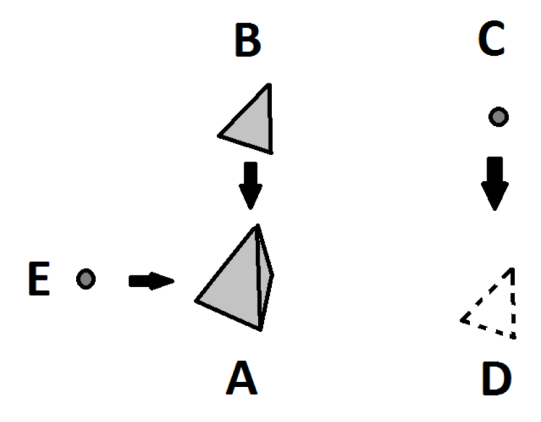Updated analyses of “Dishonored” and “Majora’s Mask 3D” are still forthcoming, friends. For the moment, I wish to offer an academic paper which I penned, in which I offer an example of how video games are uniquely equipped to tell stories that other media fundamentally cannot. Interested? Read on to find out what makes “Xenoblade Chronicles” work where “Stranger than Fiction” comes up short.
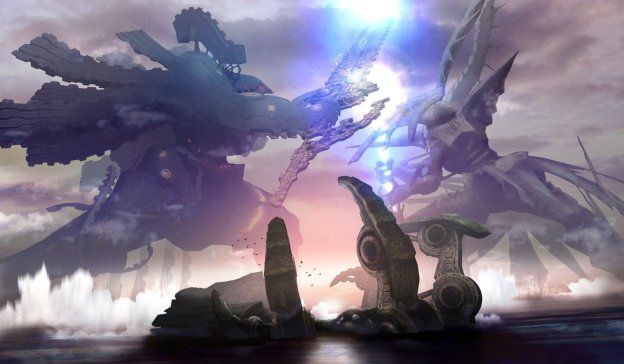
Comparative critique of nested narratives in “Stranger than Fiction” and “Xenoblade Chronicles”
With a Terrible Fate, Spring 2015
Introduction
A useful way of framing discussion of narrative is the degree to which the aesthete and author (read: writer) interact to create the story in question. I take this interaction to exist on a continuum. On one end, media such as books, though leaving the reader with agency on the level of interpretation, vest the responsibility for actual creation of the story in the author: that it to say, the content of the story is fixed by the words produced by the author, and these words remain the same irrespective of the particular aesthete who reads them. On the far other end of the spectrum, one might say, is our actual world considered aesthetically, in which the aesthete perceives (or may actually have) free will and fully realized agency, and the presence of a creator is so obscure as to constitute an entire discipline of theological and cosmic debate.[1]
Video games fall somewhere in the middle of this spectrum; we can support this claim by the fact that video games, while still clearly representing a mimetic world without total immersions, do have the potential to take the agency of the aesthete (henceforth ‘player’) as a fundamental in their narrative. “Xenoblade Chronicles” (Nintendo, 2010) offers an example of how a video game can situation of their narratives being designed by both author and player to tell stories that other media cannot. In Section I, I define what I call the “death of the author” motif as it is used in literature (not as it is used in literary theory), and explain how it theoretically falls short in the movie “Stranger than Fiction” (Zach Helm, 2006). In Section II, I explain the metaphysics and general narrative structure of “Xenoblade,” and show why it is equipped to theoretically back the death of the author motif where “Stranger than Fiction” fails. Finally, in Section III, I conclude by arguing that the mechanics crucial to achieving this motif are only in fact available to video games, which is an example of a type of story that can only be meaningfully told in this particular medium.
- The problem of authors killing themselves off
I will immediately clarify what I mean by a ‘death of the author motif’, because the term, though borrowed from literary theory, means something distinct from the “death of the author” approach to textual interpretation. It is sometimes the case, particularly with respect to stories with nested or self-referential structures, that one level of narrative is stipulated as having a particular author, who, within the larger narrative, is killed off or otherwise robbed of agency.[2] From this point, the overarching narrative must explain this substratum of narrative in a post-authorial context: perhaps it cedes control to the characters of that narrative, or perhaps it demands the reader to account for it using her own interpretive faculties. We might describe the motif I have in mind as the narrative analogue of the literary theoretical understanding of the death of the author: as the latter treats aesthetic objects as art independent of howsoever they were created, so the former tells the story of a narrative world put in the situation of existing without its stipulated creator and authority.
But there is a problem: even though this motif seems to be comprehensible, not all stories deploy it in theoretically compelling ways. We should note, of course, that stories implementing these structures will (hopefully) never be fully theoretically realizable in terms of Leibniz’s identity of indiscernibles – otherwise, killing Poe in a story would have immediately and causally lead to the death of Poe, the historical figure. Putting this aside, however, I contend that there are still methods of analysis within narrative theory to assess whether or not a story deploys this technique in a justifiable way. To explain what I mean, I offer a quick sketch of “Stranger than Fiction” and why it fails to use this motif in a compelling manner.
The film begins with a voiceover of the day in the life of Harold Crick. Soon, however, Crick becomes aware of the narrative voice, which leads him to enter a frenzied state in which he is seen by observers as schizophrenic, yelling back at a voice that no one else can here. The viewer learns that the voice is of an author (Karen Eiffel) who is writing a book about Harold, and Harold soon learns through the narration that the author plans to kill him off. Seeking advice from a literature professor, Harold takes strides to uncover the nature of his story, and tries (in vain) to escape the plot, until he ultimately locates Eiffel. At first he tries to convince her to change the ending; yet after reading it, he comes to believe that there is no other way she could possibly end the book; he therefore asks her to finish the book as planned. Yet Eiffel decides to spare Crick in an ending where he pushes a boy out of the way of an oncoming bus and is gravely injured, yet not killed – thanks to the sacrifice of his watch, which has been anthropomorphized throughout the narrative.
This is actually a rather high quality movie as far as I’m concerned, and the plot can obviously be “told” in so far as I can write it down and recount it to you in comprehensible terms; yet all the same, there is something theoretically out-of-joint afoot in this story when we actually sit down and try to parse out how the narrative functions. Here are the relevant features that together, I think, draw a contradiction, in spite of composing a coherent plot.
- Eiffel, in writing her story, inexplicably instantiates humans in her actual world.
- The humans instantiated in [1] are numerically identical to Eiffel’s characters, and their lives evolve in accordance with the narrative she writes (her typewriter, apparently, is the apparatus responsible for this. Because they are by definition characters, those with whom they interact are also characters by virtue of being part of their narrative.
- One of the humans from [1] (viz. Crick) gains awareness of the narrator describing his life, and engages with it as though it were a disembodied voice speaking to him.
- In spite of being aware that a narrator presides over his life, Crick’s life continues to evolve in accordance with [2] and be mostly narrated by the voice; however, he appears to have a limited range of leeway from the narrative in that he can: discuss the narrative in a second-order sense with a literary critic; assess whether his narrative is a tragedy or comedy; etc.
- In the leeway stipulated by [4], Crick is able to pursue the voice observed by [3], meet Eiffel, and discuss his narrative with her.
- From [5] and [2], Eiffel necessarily becomes a character in her own story, although she also must continue as the author of the story, because the story is not yet finished.
- Because of [5], Eiffel changes the ending of the story she is writing, claiming that the ending of Crick dying only worked if he did not expect it, and that a person who knowingly jumped in front of a bus to save a child could not be killed off; she instead lets him live.
- When lauded by his girlfriend that he risked his life to save a child, Crick claims that he “had no choice,” implying that his action was a result of [2].
Coherent though the plot may be, we can see that its various features stand in opposition at several points. [6] reads like a paradox: how can Eiffel write herself into a story which she then must also finish writing? But the aesthete might object here that this sounds like a complaint derived from Leibniz’s identity of indiscernibles, because the trouble is that Eiffel the character and Eiffel the author do not seem numerically identical – and we have taken Leibniz’s identity of indiscernibles off the table.
That’s a fair complaint, but the narrative trouble to which I point is actually ontologically prior to this paradox: the issue, I contend, arises from the fact that it’s not at all clear what principles we ought to use to understand [4]. It seems to me that there is no way, within or without the explicit narrative, to pin down what I pick out as ‘narrative leeway’; yet a concept such as this must be stipulated within the logic of the narrative, because it is the only move by which to explain Crick examining and interacting with the narrative descriptor on a second-order level. It is unclear how Eiffel could substantiate a character that, while still operating within the confines of the story that she architects, also appears to be privileged to a similar sort of agency that Eiffel herself has. We can understand this “half-agency” of Crick on the level of brute plot, yet it remains ontologically mysterious within the scope of the narrative, so that the viewer cannot find traction on the issue of precisely how Crick ends up moving beyond the authority of his author in the first place (and we know from [4] that he must move beyond that authority in some way).
It may well be that a clear explication of [4] would lead to a clearer conception of what is meant by the seeming paradoxical results in [5]-[8]; however, I will argue in Section III that this is precisely what a film is incapable, by limitation of the medium, of achieving. Presently, I wish to turn to “Xenoblade” to offer readers an example of how a similar narrative structure can present with less mysterious ontology.
- One solution to seeming half-agency[3]
“Xenoblade Chronicles” is superficially similar to “Stranger than Fiction” in that both stories deploy a causal framework that is instantiated by an entity with “creator” status – in “Stranger than Fiction,” this entity was an author vested with peculiar metaphysical authority; in “Xenoblade,” this entity is a scientist who literally creates a universe, in which he is the god. What I will argue is that this framework of understanding ‘authorship’ in the nested-narrative context is useful for explaining why “Xenoblade” theoretically succeeds where “Stranger than Fiction” falls short. To use this framework, we first need a provisional sketch of the narrative and metaphysics of “Xenoblade.”[4]
A note on terminology before we begin: “Xenoblade” is a complicated game to parse because it stipulates multiple universes occurring across history. As such, I will be differentiating between the ‘worlds’ of the game – i.e., particular universes stipulated within the scope of the game – and the ‘universe’ of the game, referring to the totality of space-time as defined within the game’s outermost parameters.
In the original world of “Xenoblade” – call it ‘W0’ – two scientists, Klaus and Meyneth,[5] are involved in a “phase transition experiment” in which Klaus creates a new world, collapsing their own world in the process. This experiment takes place on a space station orbiting Earth – that is to say, it is stipulated within the universe of the game that W0 is the world of the player (we will return to this later). In the new world created by this experiment, Klaus and Meyneth are gods – Meyneth’s name is “Lady Meyneth” (see footnote 5), and Klaus is called “Zanza.” Zanza, in particular, has total knowledge of the causal structure of the universe (presumably by virtue of being its creator), so we can say in this sense that divine predestination obtains. The universe so created was comprised of two colossi: the Mechonis, a mechanical colossus; and the Bionis, a biological colossus. The Mechonis is representative of Meyneth, and the Bionis is representative of Zanza; in particular, the gods are described as the “souls” of these colossi. Diverse life forms, created by Zanza and Meyneth, populated both the Mechonis and Bionis, and took the colossi to be their home. This describes the most basic ontology and metaphysics of a particular world within the game’s universe following W0.
Zanza, however, was apparently a lonely god who feared the creatures of his world forgetting his status as their god. As such, he would periodically destroy the current world and give rise to a new one. Eventually, Meyneth took up arms in an effort to stop him and protect the creatures of the world; the two colossi, harboring Zanza and Meyneth as their souls, did battle, and eventually fell dormant as Meyneth was weakened and forced into stasis, and Zanza was imprisoned on the Bionis, falling dormant as well.
The setting for almost all of the game’s playable narrative is an nth such world. The player typically controls a party of multiple characters, but the narrative is focalized on one particular character as the player’s main point of access into the world: Shulk. Shulk is crucial as a character because of his relationship to Zanza, and to a sword called the Monado. When Shulk was young, he and his family came across a cave sheltering the Monado; all perished but Shulk, and Shulk developed a “bond” to the sword. Though the player doesn’t know at the beginning of the game, this “bond” is actually the fact that Zanza’s spirit, contained within the blade, came at that time to rest dormant within Shulk, waiting until late in the game to cast Shulk off as an empty shell and return in his full-fledged god form. In fact, it is within the conceit of the game that Shulk died along with the rest of his family in the cave; according to Zanza, only his (i.e., Zanza’s) spirit was animating the boy. Yet somehow Shulk returns from the dead to confront Zanza with his friend, ultimately killing the god. We will have to explain how the game can justify such a resurrection – but first, a brief digression into the Monado and Leibniz is in order.
Within the conceit of the game, the Monado is most immediately understood as a sword with the ability to perceive the future and alter reality in various ways. The game is unclear about precisely how this happens, but we can take what is happening roughly as follows: the world at bottom is a wave function in the medium of ether (“ether” is in fact explicated within the game as the world’s fundamental constituent; the wave function formalization is left implicit). The Monado is able to read this function, which is identical to the world’s causal structure as it evolves over time; and, in so doing, the wielder of the Monado (read for the moment: Shulk) can perturb the wave function so as to change the course of future events (more on the specifics of this in a moment).
However, there are other claims explicated within the game as to what the Monado is. When Zanza the god first appears after freeing himself from Shulk, he says the following to Shulk’s friends: ‘“Do not be surprised. Everything in this world is dictated by the passage of fate. As all that exists is interconnected, time can only flow toward the inevitable. That is the vision of which I, the Monado, am the origin.” Here, Zanza identifies himself with the Monado, which makes sense in so far as we have seen divine predestination obtain: the notion at this point in the game is that, even though Shulk thought he was able to change the future, he was actually being lead through a series of events foreseen by Zanza, a god who is both responsible for the causal chain of the world, and also omniscient with respect to it.
Yet after Shulk comes “back from the dead” and confronts Zanza with his friends, the concept of the Monado seems to evolve. The physical sword Monados were, after Zanza’s exposition, taken to be articles of gods, representative of their causal omniscience and omnipotence (Meyneth and Zanza both had Monados; but in the aftermath of Zanza’s reappearance, Zanza struck down Meyneth and took her Monado for himself); however, Shulk summons his own, third Monado in the final confrontation, which allows him to see the future and counter Zanza himself. Thereafter, we see the game’s final explanation of the Monado concept: a mysterious character who has guided Shulk at crucial points in the narrative, Alvis, reveals that he is actually “the system administrator of [the] phase transition experiment,” and that he is numerically identical with the Monado.
In order to gain traction with the game’s conception of Monados, which is crucial to its narrative structure, I propose a move to Leibniz’s monadology. Of course, the explicit reference to the ‘monad’ could just as well hearken back to the Greeks as to Leibniz’s metaphysics; however, I think we have good reason to believe the intended reference was Leibniz, and also contend that his metaphysics offers us a generally useful mode of thought with which to analyze the narrative. I will offer my analogy and interpretation of Leibniz (as explained by Jeff McDonough, in particular) as a way into analysis.
Leibniz’s mature metaphysics held that organic beings were essentially ‘machines with souls,” and that inanimate objects were comprised of a multitude of organic beings. Taking such a view, one can reduce reality ultimately to a collection of ‘souls’, by repeatedly taking the souls out of organic beings, and then analyzing the machines left over as a collection of organic beings. The souls, on Leibniz’s view, are monads, simple mind-like substances with perception and desire but without extension. This mode of representation is pervasive in “Xenoblade” and forms the basis of what I would call a fractal kind of reality: the same conflicts and relationships played out by the Mechonis and Bionis are played out by Meyneth and Zanza, and are also played out by Shulk (Zanza’s vessel) and Fiora (Shulk’s friend, and Meyneth’s vessel). More literally, the Bionis is a being that is comprised of a soul (Zanza) and a corpus, constituted by all varieties of living creatures. The same analysis holds on a variety of other levels in the game, but this will suffice to make the point.
Consider also the causal structure of the world, as initially stipulated: the world evolves from an initial state as ordained by its omniscient god. While this variety of divine predestination is not unique to Leibniz, it is in accordance with his metaphysics. The name of the swords themselves is misleading, because I see no way to reconcile them directly as mind-like fundamentals; nonetheless, I think this is sufficient to stipulate that even if the finer points of Leibniz’s metaphysics are not articulated, then its general shape is present in the world constituting most of the main narrative; and Monados, too, have a place in this. Where this framework is most useful, however, is in the places where the world’s ontology breaks with Leibniz.
Recall the words of Zanza when he manifests himself independently of Shulk for the first time: “As all that exists is interconnected, time can only flow toward the inevitable. That is the vision of which I, the Monado, am the origin.” This is a strange thing for a god in Leibniz’s world to say, because the predestined evolutions of monads are causally independent from one another; rather, the monads only perceive themselves as causally related, a sort of misconception referred to by Leibniz as ‘pre-established harmony’. I don’t take this as a reason to dismiss Leibniz’s influence on the world’s metaphysics; rather, I see it as a clue explaining how the narrative describes the collapse of a world by the introduction of an external agent: the player.
In my previous work on “Legend of Zelda: Majora’s Mask” (Nintendo, 2000), I defended a view that the agency of the player can serve a significant role in the narratives of video games, and I think the explanatory work such agency does in this case is an increasing amount of control over the world’s causal chain as the narrative progresses. I describe the narrative in this light as a four-stage progression.
In Stage 1 (from entry into the game until introduction of the Monado’s vision mechanic), the player enters the narrative and is presented with a rote script. She must follow the objectives laid out by the game, and has no conception of how to meaningfully alter that script. This stage is similar to the act of reading a book, as described in this paper’s introduction.
In Stage 2 (from the introduction of the Monado’s vision mechanics through Zanza’s differentiation from Shulk), the player has the false perception of influence over the narrative. The mechanics of the Monado imply to her that she is able to meaningfully alter the world’s causal structure by deciding how to act on visions presented; yet Zanza’s exposition reveals that the unfolding of all events up to that point were part of his plan, thereby declaring the player impotent with respect to narrative impact.
Yet in Stage 3 (from after Zanza’s manifestation up to killing Zanza), Shulk returns independently of Zanza and challenges what the god describes as ‘inevitable fate’. I argue that Shulk’s return is explicable by the same reason why he ultimately generates a third Monado: the player acts as his soul, and perpetuates him in a world where he has been used and eschewed by a god. This is where the player begins to make a difference: by reconstituting Shulk independently of Zanza, the player has the opportunity to utilize the Monado’s mechanics so as to actually change the causal structure of the world; a degree of freedom which culminates in killing Zanza. Zanza unwittingly forecasts this agency in moment of his causal confusion, which describes him as part of the monadology rather than its omniscient origin (we will return to Zanza’s place in all this in a moment).
I pause to clarify what I mean by “changing the causal structure of the world.” I don’t mean to imply that the player, in choosing how to act on an event forecasted by the Monado, instantiates a new universe via a collapse event, or anything so complicated. I find it more parsimonious to explain this in terms of counterfactuals: suppose a view of possible worlds such that the nearest possible worlds are those with the ‘smallest miracles’ necessary to alter the chain of events in the actual worlds. So we might say that the player does, in fact, have the ability via exercising her agency through the mechanic of the Monado to move the narrative to other, relatively local, nomologically possible worlds; but I flag for the reader that these are, relatively speaking, small jumps between possible worlds.
This matter of small jumps contrasts sharply with Stage 4 (from the killing of Zanza to the end of the game’s main plot), in which Alvis intercedes as the Monado, explains the universe’s ontology to Shulk (and, by extension, to the player), and tells Shulk that, by virtue of killing Zanza, he has ended this world, and must now choose a new world to create, as its new god. Shulk opts for “a world without gods.” The player’s agency, through this extension of the endgame, has undone the world in which the entire narrative thus far has taken place, leading to the instantiation of a new universe without gods – precisely what I had in mind with the ‘death of the author’ motif. Killing Zanza, therefore, constitutes the narrative’s apex of authority being vested in the player’s agency as opposed to the author, as represented by Zanza: in his death, the entire framework of the game is cast away and replaced with something new, at which point the game concludes.
The position of the player as an external agent relative to the game is crucial to why this death of the author motif is aesthetically consistent, in contrast to the more problematic model of “Stranger than Fiction.” By the game’s stipulation, Klaus is from the same world in which the player currently exists – Earth – and Klaus, through his phase transition experiment, has created a universe that, by virtue of his role in creating it, takes him as its god. Yet this also subordinates Klaus to the role of Zanza, bounded by the universe that he created. If this was the entire existential domain, then that would not be a problem for him; but the player exists in the world from which Klaus first engaged in his phase transition experiment, and is therefore able to affect the universe as an agent positioned to view the entire causal structure of the universe, including its god. This is the crux of why Zanza is able to be killed in a way that doesn’t feel problematic to the narrative: like Eiffel in “Stranger than Fiction,” he renders himself a character in his own world, but unlike Eiffel, authorship is narratologically transferred to the player and Shulk, who override Zanza and render him null.
III. The unique capacity of video games to kill the author
It seems to me, in closing, that the difference in structure that allows “Xenoblade” to avoid the ontologically mysterious aspects of agency troubling “Stranger than Fiction” is a direct result of the story’s status as a video game. To see what I mean, consider the problem framed as followed: if the characters created by an author within a broader narrative are to take control of the story away from the author, than they must be vested with agency at least equivalent to that of the author; otherwise, it is mysterious how entities whose existence is totally determined by another entity could surmount that entity. It isn’t clear how the author could design characters with the same amount of agency as her, while still dictating the story in which those characters exist; and, if the author creates agents without dictating the story, then these agents seem more like automata than characters as typically understood. So it seems like the only option to traditional media is to stipulate something metaphysically clunky – e.g., “God decides, for some reason, to transform these characters into full-fledged agents, on the same level as their author.” Yet even this doesn’t map directly onto what happens in “Xenoblade,” because such a state of affairs effectively liberate the characters from the story, without the characters themselves acting against the author in order to destroy or reshape the story. We can keep adding metaphysical qualifications, but the account will continue to lose parsimony.
Video games, however, offer a compact and intuitive way of facilitating just this sort of narrative: characters in a video game, such as Shulk, can at once be ontologically related to a god or author, like Zanza, and can also derive their agency from an external source: the player. In this case, a narrative telling a variation of the death-of-the-author motif amounts to a shift between the relative authority of the author and player within the scope of the plot. This is why I posit that stories like “Xenoblade,” in spite of having plots that can be conveyed in the written word, can only be understood in a sound theoretic lens when represented through the vehicle of video games. We may well find in future studies that other motifs are similarly limited to video games, just as novels, for example, can represent things in ways that other media cannot.
[1] If the real world is a troubling example, then one might instead imagine a total immersion virtual reality experience a la “The Matrix” (Andy Wachowski & Lana Wachowski, 1999), in which the aesthete is fully emerge in a universe that, while designed by someone, is perceived by the aesthete to be without a definitive, foregrounded creator.
[2] For a discussion of this structure as exemplified by Poe’s Arthur Gordon Pym, see Umberto Eco’s Six Walks in the Fictional Woods, pp. 17-20 (Harvard University Press, 1994).
[3] I am indebted in this section to Professor Jeff McDonough for clarifying Leibniz’s metaphysics for the purposes of my analysis. Note that no views offered here are meant to reflect Professor McDonough’s views.
[4] Unlike the sketch of “Stranger than Fiction,” this sketch will not be chronological with respect to the narrative. The reason why is because “Xenoblade” offers a story in which the beginnings of the universe, along with its general ontology, are revealed at late stages in the game, such that the player must effectively play through the narrative a second time in order to understand the ontology of the events in the early parts of the story. While intrinsically interesting, this is all peripheral to the matters at hand.
[5] A technical note: it is unlikely that “Meyneth” is actually the name of the second scientist. She is only named this because, as I will explain, a character from within a later world is relating her to her analogous form in his own world – a form named “Lady Meyneth.” We never hear her referenced by name in our one glimpse into W0, and therefore do not have confirmation on her actual name; on the other hand, we see in this glimpse that she refers to the other scientist as “Klaus,” and we can therefore assume this to be his actual name.




